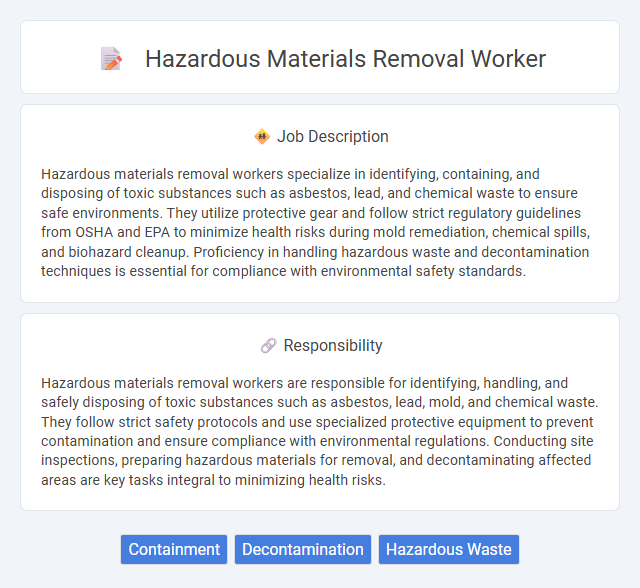
Hazardous materials removal workers specialize in identifying, containing, and disposing of toxic substances such as asbestos, lead, and chemical waste to ensure safe environments. They utilize protective gear and follow strict regulatory guidelines from OSHA and EPA to minimize health risks during mold remediation, chemical spills, and biohazard cleanup. Proficiency in handling hazardous waste and decontamination techniques is essential for compliance with environmental safety standards.
Hazardous materials removal workers are likely to be suitable for individuals who can tolerate physically demanding conditions and maintain composure in high-risk environments. Those with a strong attention to detail and the ability to follow strict safety protocols may find this job well-suited to their skills. It is probable that people with respiratory issues, claustrophobia, or a low stress tolerance might find this occupation challenging or unsuitable.
Qualification
Hazardous materials removal workers must have specialized training in handling toxic substances, including asbestos, lead, and chemical waste, often requiring certification such as OSHA HAZWOPER. Proficiency in using personal protective equipment (PPE) and adherence to safety regulations and environmental laws is critical to minimize exposure risks. Physical stamina, attention to detail, and strong knowledge of decontamination processes are essential qualifications for effective and safe hazardous waste removal.
Responsibility
Hazardous materials removal workers are responsible for identifying, handling, and safely disposing of toxic substances such as asbestos, lead, mold, and chemical waste. They follow strict safety protocols and use specialized protective equipment to prevent contamination and ensure compliance with environmental regulations. Conducting site inspections, preparing hazardous materials for removal, and decontaminating affected areas are key tasks integral to minimizing health risks.
Benefit
Hazardous materials removal workers likely benefit from competitive salaries due to the specialized skills required for safely handling toxic substances. Health insurance and retirement plans may be common, reflecting the physically demanding and high-risk nature of the job. Workers might also receive specialized training and certifications, which can enhance job security and career advancement opportunities.
Challenge
Hazardous materials removal workers likely face considerable challenges related to safety due to exposure to toxic substances and dangerous environments. They probably require rigorous training and adherence to strict protocols to minimize health risks and prevent contamination. The job might also demand physical endurance and the ability to remain calm under pressure in unpredictable situations.
Career Advancement
Hazardous materials removal workers can advance their careers by obtaining specialized certifications such as OSHA HAZWOPER, lead abatement, and asbestos removal licenses, which increase job opportunities and earning potential. Gaining experience in project management and safety supervision often leads to roles as site supervisors or environmental health and safety specialists. Pursuing further education in environmental science or industrial hygiene can also open pathways to higher-level positions in environmental compliance and risk assessment.
Key Terms
Containment
Hazardous materials removal workers specialize in containment by isolating dangerous substances to prevent environmental contamination and health risks. They deploy advanced barriers, negative air pressure systems, and sealing techniques to securely enclose asbestos, lead, mold, and chemical spills. This precise containment process is critical for safe transport and disposal, complying with OSHA and EPA regulations.
Decontamination
Hazardous materials removal workers specialize in decontamination processes to safely eliminate toxic substances such as asbestos, lead, or chemical waste from buildings and sites. They utilize protective equipment and follow strict safety protocols to prevent contamination spread and ensure compliant disposal of hazardous materials. Expertise in environmental regulations and proper containment techniques is critical for effective hazard mitigation and site restoration.
Hazardous Waste
Hazardous materials removal workers specialize in identifying, handling, and disposing of hazardous waste substances, ensuring compliance with environmental regulations and safety standards. Their tasks include decontamination, containment, and transportation of materials such as asbestos, lead, chemical waste, and biohazards to approved disposal facilities. Proper use of protective equipment and adherence to OSHA guidelines are critical to preventing exposure and environmental contamination during hazardous waste removal operations.
 kuljobs.com
kuljobs.com